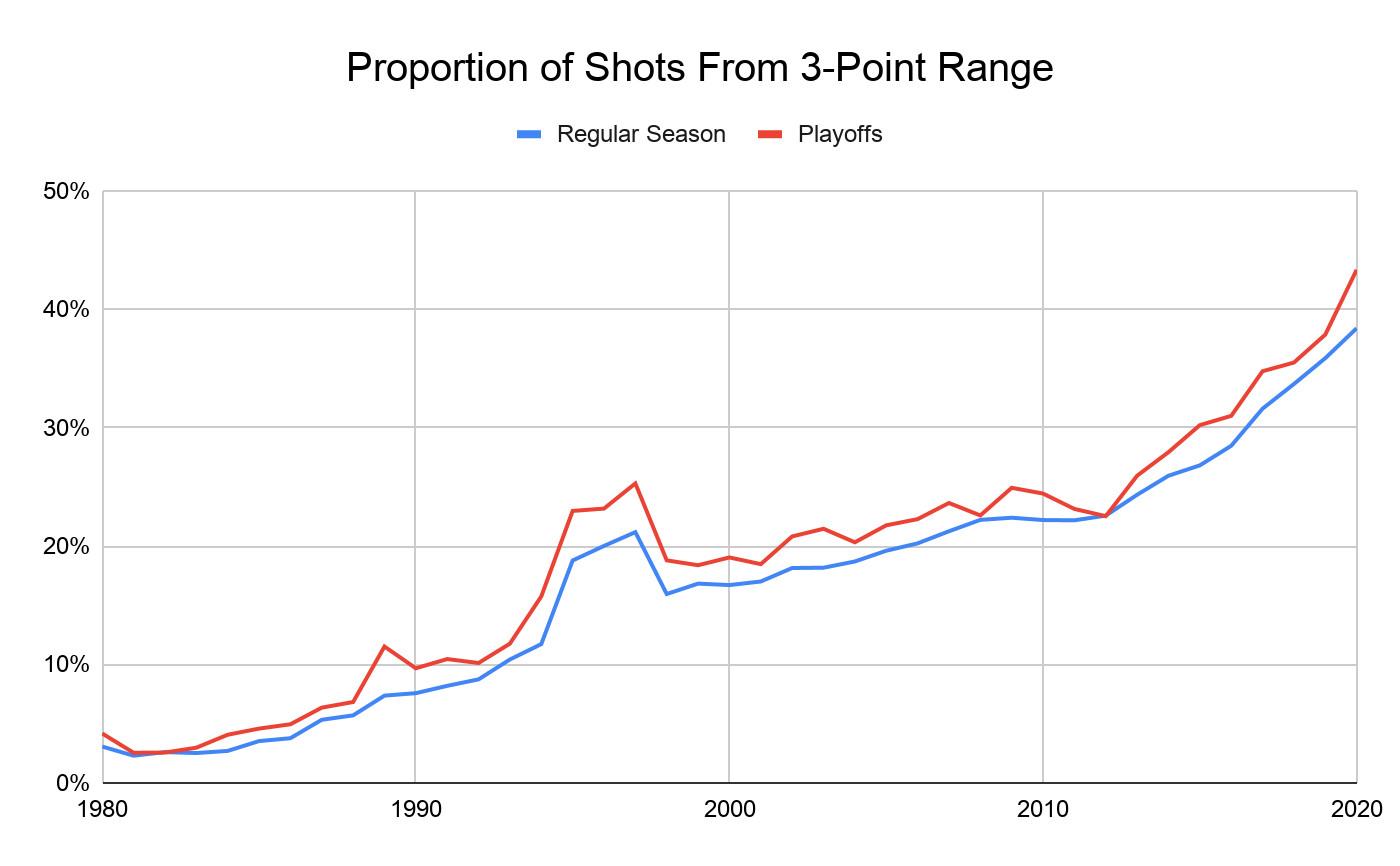It took less than a week of games inside the NBA bubble for players to notice a change in the scoring environment. “I feel like it’s a hooper’s gym,” Devin Booker said, as his Suns were en route to an 8-0 record and astounding 120 points per 100 possessions. “It’s easier to shoot in here.”
Throughout the seeding games, it really was easier to shoot there. Although offensive efficiency typically nosedives after long layoffs—either due to a lockout or a generic offseason—the league’s average offensive rating actually rose in the seeding games, as compared with the pre-shutdown regular season. And now, with the playoffs more than halfway over, we can examine the postseason data to check whether the Disney gyms really are for hoopers.
Whether due to better defenses, better scouting, fatigue, or all of the above, 3-point accuracy drops in the playoffs every season, by around 2 percentage points leaguewide. But so far this postseason, the league is shooting slightly better on 3s. The improvement is small and might regress as the postseason continues, but it’s meaningful when contrasted with the alternative. Here’s how the past half-decade compares to the 2019-20 postseason.
3-Point Percentage in the Playoffs vs. Regular Season
(Note: To calculate these regular-season percentages, I weighted players’ regular-season attempts proportionally by their playoff attempts. That’s important for an apples-to-apples comparison because better shooters make up more of the player pool in the playoffs. In the 2015-16 postseason, for instance, Klay Thompson and Steph Curry combined to take 10 percent of the whole league’s 3s; in the regular season, they were at just 2.6 percent.)
Interestingly, playoff shooting tends to suffer on both wide-open attempts (defined by NBA Advanced Stats as when the closest defender is at least 6 feet away) and more contested attempts. Yet this season, playoff shooting has ticked up in both categories, most prominently on open 3s.
3-Point Percentage by Defender Distance
These aren’t major differences; a gap of 2.5 percentage points of accuracy between what normally happens in the playoffs and what’s happening this season means only one extra make out of every 40 shots. But with teams averaging about 40 3s per game, even this small difference matters.
Indeed, 3-pointers are flying like never before. (It seems like we could write that sentence every month at this point.) A whopping 43 percent of shots this postseason come from 3-point range—a massive increase even over previous highs. The league’s 3-point attempt rate usually rises a small amount in the playoffs, but the gap between regular-season and postseason rate has never been higher than it is right now.

The league’s offensive gains over past postseasons aren’t limited to 3-point range, though that’s where the strongest evidence lies. As I’ve written previously, the playoff percentage drop is not exclusive to 3-pointers; free throw and 2-point accuracy tends to fall, too. This postseason, the decline in free throw accuracy is still present, but the 2-point drop is a lot less severe.
Playoff Decline in Shooting Percentage
While on the subject of 2-pointers, excuse a quick aside about the midrange, as teams like the Rockets and Bucks struggle to score against set defenses. Offensive diversity matters. But it’s also worth considering that the teams with the most midrange attempts per game this postseason are the Magic, Trail Blazers, and 76ers, while the most accurate midrange teams are the Mavericks and Thunder. All five clubs lost in the first round.
Why is playoff shooting better—or at least not worse—than it was in the regular season? Numerous theories abound, and so much has changed this postseason that it’s impossible to isolate any one variable. Here are just a few, any of which might mean nothing on its own but could explain all or part of this phenomenon:
- The long layoff may have counteracted the fatigue of a long season, with players having just a dozen recent games on their odometers now, instead of 80-plus.
- Playing in the same gyms game after game might help, the same way a familiar home court does in the regular season.
- Without fans crowding the court, extra room on the baselines and sidelines might make players feel more comfortable beyond the arc; accuracy on corner 3s in particular is up inside the bubble.
- Defenses might be out of sync without much recent practice time.
- Players are drawing more fouls on jump shots, so closely contested misses won’t actually count toward shooting percentages.
- Players might benefit from a lack of cross-country travel.
This last theory is worth further consideration, because while the NBA certainly hopes never to eliminate travel completely again—travel, of course, is necessary to play games in front of home fans, which contributes vast sums to the league’s bottom line—it can at least work to reduce the miles that teams amass over a season. Jazz vice president Dennis Lindsey, whose team ranked first in 3-point percentage in both the regular season and postseason, said Wednesday that he thinks the lack of travel has improved play inside the bubble—and that players seem to agree. “The players feel better, and frankly, we need to listen to the players,” he told ESPN’s Tim MacMahon. To translate that impulse to a normal season, Lindsey suggested reducing travel, which could perhaps be accomplished with consecutive games held against the same team in the same arena, like in baseball.
Meanwhile, back in the playoff bubble, players are reaping the benefits of staying put. These 10 players have made the most playoff 3-pointers above what they would have expected to make, based on their regular-season rates and distribution of open and contested 3s. Four players from the rollicking Denver-Utah first-round series appear in the top five, which helps explain why that seven-gamer was so enthralling.
2019-20 Playoff 3-Pointers Above Expectation
Conversely, here are the 10 greatest underperformers so far. The Clippers are title favorites even with their two stars shooting worse than expected.
2019-20 Playoff 3-Pointers Below Expectation
The 2019-20 postseason isn’t over yet, so these numbers still have room to slide around, and any movement is worth monitoring—both for the current championship race and the league’s future decisions around, say, travel and crowd proximity to the court. But at this point, it’s difficult to envision a complete reversion to the playoff norm. The postseason is already more than halfway over, and the gyms still belong to the hoopers.
Statistics through Tuesday’s games.
